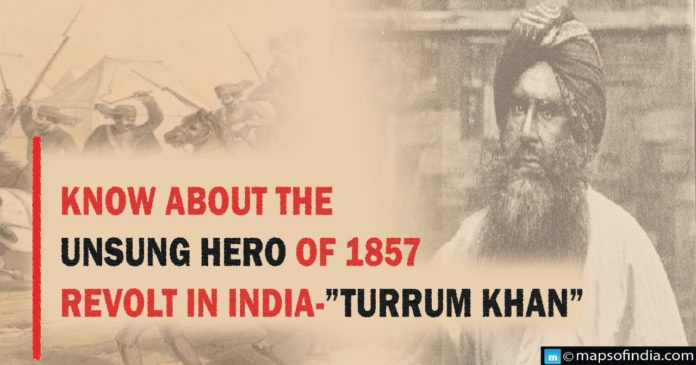Undoubtedly, 1857 is the hallmark year in the history of the Indian independence movement. The whole moment pushed the freedom struggle a step forward while keeping the fighting spirits higher than ever before. The East Indian Company of the British is a great lesson of “Never underestimate the Indians”.
The Indian movement taught the colonizing British that it wouldn’t be a piece of cake handling the native of a colonized place. Mangal Pandey, Nana Sahib, Tanta Tope, etc., are some well-known figures associated with the 1857 Indian revolt. Still, the unsung hero fought fearlessly in the Nizam’s Hyderabad state, and he is “Turrebaz khan”, popularly known as “Turrum Khan”.
Tale of Turrebaz Khan
As part of the agreements made with the princely states, the British summoned the Nizams to send in military support to curb the revolt in the north. Public, senior soldiers, and other intellectuals in the state were against sending state members to act against the revolt, and among them was Turrebaz Khan. A resident of Hyderabad was unhappy with the Nizam’s decision to send in military support. Khan gathered support from a famous local religious preacher Alavudin Maulvi and other military men. As part of Khan’s revolt, they gathered arms and attacked the British residency in Koti on July 17th, 1857. Other prominent Jaigopal Das Abbas Saheb accommodated them in Puthibouli. Khan and his men managed to break down the left entrance of the residency and entered the premises. However, all they received was a heavy blow from the existing garrisons and fought until early morning. They suffered losses, and Khan escaped into the Shadnagar forests.
However, the Nizam managed to arrest him by July 22nd, and the authorities made arrangements to send him exile to the notorious jails of Kalapani. Meanwhile, the heroic Khan managed to make another great escape, and this time he took cover in Thupran forests. The reward for his capture was 5000 Rs (which is worth 50 lakhs compared to today’s currency value), and finally, a nizam official named Khurban Ali Khan traced Turrebaz khan and shot him to death for money.
The British wanted to make Khan’s case an example to all the empathizers of the revolution and confirm that the British had zero tolerance towards any resistance shown by the natives. So, Khan’s body was hanged to a tree in front of the British residency, a display of no mercy to death. In exchange, the Nizams received a debt waiver of 55 lakh.
If this is a suppressed story of an unheard revolutionary figure in Hyderabad, southern India has numerous stories. The impact Khan made was not an ordinary one or not a kind that deserves to get lost in the ravages of time. If his attempt to free the motherland was successful, it could have counter-produced extreme reactions easily elsewhere and brought the colonies down.




